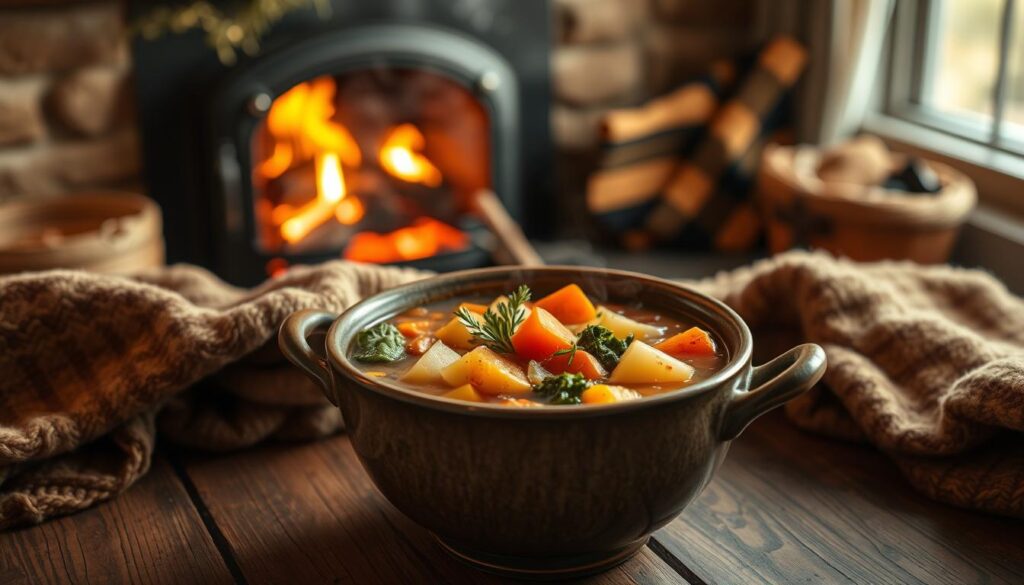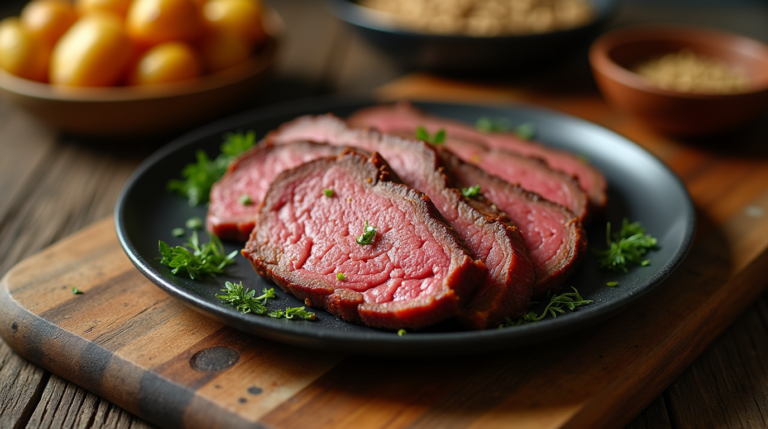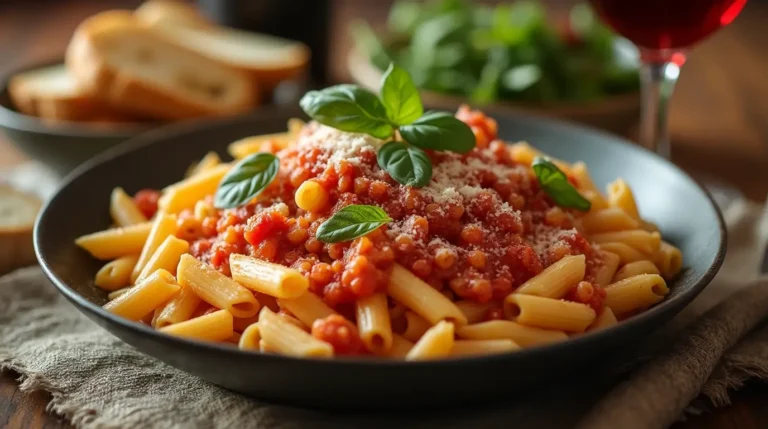Cozy Winter Soup Recipes to Warm Your Soul
Table of Contents
When it gets cold and dark, a warm bowl of homemade soup is just what you need. It’s the perfect comfort food for the winter. This article will show you a range of delicious winter soups to make your taste buds happy and your belly full.

Key Takeaways
- Discover a variety of homemade winter soup recipes to combat the cold
- Learn about essential kitchen tools for perfecting your soup-making skills
- Explore flavorful soup bases and hearty protein-rich options
- Uncover time-saving tips for efficient soup preparation
- Dive into the health benefits of nourishing winter soups
Embracing the Magic of Homemade Winter Soups
Winter’s chill brings a cozy comfort from homemade soup’s aroma. Making your own soup is rewarding and beneficial. It’s more than just a meal; it’s a joyous experience.
Homemade soup is cost-effective. You save money by using your own ingredients and controlling portions. Cooking techniques like slow simmering boost the nutritional value. This ensures every spoonful is full of vitamins and minerals.
Making soup at home is therapeutic. The chopping and simmering have a calming effect. It’s a perfect activity for the winter.
Homemade soups let you customize flavors and ingredients. You can make a dish that suits your taste perfectly. It’s great for trying new things or making family favorites.
As winter gets colder, enjoy making homemade winter soups. They offer many benefits and are a joy to make. They nourish your body and soul with their comforting flavors.
Essential Kitchen Tools for Perfect Soup Making
Creating delicious winter soups needs the right kitchen tools. From strong stock pots to handy immersion blenders, the right tools are key. They help achieve the perfect texture and flavor. Let’s look at the kitchen equipment, soup-making tools, and culinary essentials you’ll need.
Stock Pots and Dutch Ovens
A good stock pot or Dutch oven is crucial for making soups. These pots are made for simmering and slow-cooking. They help your soups get rich, complex flavors. Choose heavy-duty, stainless steel or enameled cast-iron pots for long cooking times.
Immersion Blenders and Strainers
An immersion blender is great for smooth soups. It lets you puree ingredients right in the pot. This saves you from transferring hot soup to a blender. Pair it with a fine-mesh strainer for easy soup making.
Storage Containers and Freezing Tips
After making your soup, storing it right is important. Get high-quality, airtight containers for fridge and freezer use. When freezing, leave space for expansion. Also, portion your soup for easy reheating.
| Tool | Purpose | Recommended Brands |
|---|---|---|
| Stock Pot | Simmering and slow-cooking soups | All-Clad, Le Creuset, Cuisinart |
| Immersion Blender | Pureeing ingredients directly in the pot | Breville, KitchenAid, Braun |
| Storage Containers | Preserving soup flavors and texture | Pyrex, Ziploc, Rubbermaid |
Hearty Winter Soup Recipes for Cold Days
When winter winds blow and temperatures drop, a warm bowl of homemade soup is perfect. Our collection of hearty winter soup recipes will warm your soul. They offer classic comfort and new flavors to beat the cold.
Beef Stew with Vegetables
Beef stew is a timeless favorite. It combines tender beef, potatoes, carrots, and onions in a rich broth. Serve it with crusty bread for a complete meal.
Creamy Chicken Noodle Soup
Our creamy chicken noodle soup is a winter must-have. It has tender chicken, egg noodles, and a creamy broth. Add fresh parsley for a burst of color and taste.
Hearty Minestrone Soup
Minestrone soup is packed with vegetables, beans, and pasta. It’s both healthy and tasty. Use your favorite seasonal produce to make it even better.
| Recipe | Prep Time | Cook Time | Total Time |
|---|---|---|---|
| Beef Stew with Vegetables | 30 minutes | 2 hours | 2 hours 30 minutes |
| Creamy Chicken Noodle Soup | 20 minutes | 45 minutes | 1 hour 5 minutes |
| Hearty Minestrone Soup | 25 minutes | 1 hour 15 minutes | 1 hour 40 minutes |
Looking for a classic soup or something new? These recipes will warm you up and fill your belly. Enjoy these winter soup ideas, classic recipes, and comfort food favorites.
Building Flavorful Soup Bases From Scratch
Making tasty homemade soups begins with a good stock or broth. Preparing a flavorful soup base can make your winter soups even better. Learn how to make stock and bone broth and add the right herbs and spices for great taste.
Vegetable Stock Fundamentals
Vegetable stock is great for many meatless soups. Start by sautéing onions, carrots, celery, and garlic. Then, simmer them in water with herbs like thyme, parsley, and bay leaves.
Let it simmer for an hour or more. This way, the flavors mix well, making a delicious homemade stock. It’s perfect for your favorite soup base recipes.
Bone Broth Techniques
For a richer soup base, try making bone broth. Roast beef, chicken, or turkey bones and simmer them in water. Add onions, garlic, and peppercorns for extra flavor.
The long simmering extracts gelatin and minerals from the bones. This makes a nourishing broth that adds depth to your winter soups.
Herb and Spice Combinations
Once your stock or broth is ready, play with herbs and spices. Try different mixes to find the best flavor enhancement for your soups. Thyme, rosemary, and bay leaves are classic choices.
Or, mix cumin, coriander, and chili powder for a unique taste. Fresh herbs like parsley, cilantro, or basil add a bright finish to your soups.
With a great homemade stock and the right herbs and spices, you’re set for delicious winter soups. Dive into the world of soup base recipes and enjoy cozy, flavorful soups all season.
Creamy Vegetarian Soups for Cozy Nights
Winter brings a chill that only a warm bowl of soup can beat. Vegetarian soups are a great choice, offering a tasty, meat-free option. They’re creamy, comforting, and can be made without dairy.
The Butternut Squash Soup is a standout vegetarian recipe. It combines roasted butternut squash with onions, garlic, and spices. This mix creates a rich, velvety flavor. Another favorite is the Potato Leek Soup, with its creamy texture and sweet leeks.
Looking for something dairy-free? Try the Creamy Tomato Soup. It’s made with plant-based soups and has a silky texture. The soup is full of tangy tomatoes, herbs, and a smooth feel in your mouth.
| Soup Recipe | Key Ingredients | Cooking Time |
|---|---|---|
| Butternut Squash Soup | Butternut squash, onions, garlic, spices | 45-60 minutes |
| Potato Leek Soup | Potatoes, leeks, onions, broth | 60-75 minutes |
| Creamy Tomato Soup | Tomatoes, onions, garlic, herbs | 30-45 minutes |
Explore the world of vegetarian recipes and enjoy these dairy-free, plant-based soups on a cold winter night.
Protein-Rich Winter Soup Variations
As winter comes, we all crave warm, filling meals. Soup is the ultimate comfort food, especially when it’s packed with protein. Discover these protein-rich soups to nourish your body and warm your heart.
Bean and Lentil Options
Beans and lentils are great for protein and are easy on your wallet. Try a creamy white bean soup or a hearty lentil stew with spices. These high-protein soups are tasty and full of fiber and nutrients for the cold months.
Meat and Poultry Additions
Looking for hearty meals with more protein? Add lean meats or poultry to your soups. A chicken noodle soup or a beef and barley stew is both tasty and nutritious. These nutritious recipes offer a mix of protein, carbs, and veggies for a fulfilling meal.
Seafood Soup Specialties
Feeling adventurous? Try a seafood soup. From creamy chowders to fragrant bouillabaisse, these high-protein soups with fish, shrimp, or mussels are a tasty twist. They’re also a great source of lean protein and omega-3s for your health.
| Soup Variation | Protein Source | Nutritional Benefits |
|---|---|---|
| White Bean Soup | Beans | High in plant-based protein, fiber, and complex carbohydrates |
| Chicken Noodle Soup | Chicken | Provides lean protein, vitamins, and minerals |
| Seafood Chowder | Seafood | Rich in protein, omega-3 fatty acids, and essential nutrients |

Adding protein-rich ingredients to your winter soups makes them more nutritious and filling. Try different high-protein soups, hearty meals, and nutritious recipes to find your new favorite dishes.
Time-Saving Winter Soup Preparation Tips
Preparing winter soups can take a lot of time. But, with smart strategies, you can make tasty meals quickly. Use these meal prep, quick recipes, and cooking hacks to make soup-making easier.
Batch Cooking for Efficiency
One great trick is to make more soup than you need and freeze it. This meal prep method lets you have soup ready to go whenever you want. Just thaw and reheat for a quick, satisfying meal.
Slow Cooker Simmering
Use your slow cooker to make soup-making simpler. It lets your ingredients simmer while you do other things. Just add the ingredients, set the timer, and come back to a delicious soup.
Ingredient Shortcuts
- Choose pre-chopped veggies to save prep time.
- Have frozen herbs and spices ready for flavor boosts.
- Use canned or jarred broths and stocks for a quick soup base.
Adding these cooking hacks to your soup-making can save a lot of time. You’ll enjoy making delicious, homemade winter soups without much effort.
Soup Garnishing and Presentation Ideas
Turning homemade soups into a feast for the eyes and taste buds is fun. You can use fresh herbs, crunchy toppings, and creamy finishes. These ideas make your soup look and taste amazing.
Fresh Herb Combinations
Fresh herbs can really make your soup pop. Try mixing chopped parsley, thyme, and chives on top. Or, add a dollop of pesto or gremolata for a fresh taste.
Crunchy Toppings
- Toasted breadcrumbs or croutons for a satisfying textural contrast
- Crispy fried onions or shallots to add a savory crunch
- Roasted nuts, such as almonds or pecans, for a delightful nutty flavor
Cream and Cheese Options
| Topping | Flavor Profile | Recommended Soup Pairings |
|---|---|---|
| Swirled cream or yogurt | Creamy, tangy | Broccoli, potato, or butternut squash soup |
| Grated Parmesan or crumbled feta | Savory, salty | Tomato, minestrone, or lentil soup |
| Shredded cheddar or gouda | Rich, melty | Chicken noodle, corn chowder, or beef barley soup |

Using these food presentation tips can make your soups stand out. Try different soup toppings and culinary aesthetics to find your favorite. Every bowl will be a treat for your eyes and taste buds.
Health Benefits of Winter Soups
When it gets colder and the days are shorter, we all want something warm and nourishing. Winter soups are perfect for this. They’re full of immune-boosting ingredients and balanced nutrients that meet our seasonal needs.
Winter soups help us stay hydrated. They’re mostly water, which is great for keeping our bodies moist. This is especially important in the dry winter months. It helps our organs work better and keeps us feeling good.
Winter soups are also packed with nutrients. They’re made with a mix of vegetables, proteins, and herbs. This means they keep a lot of vitamins, minerals, and antioxidants. These nutrients help boost our immune system and keep us healthy.
| Nutrient | Benefits |
|---|---|
| Vitamin C | Supports immune function and collagen production |
| Zinc | Aids in wound healing and immune response |
| Vitamin A | Promotes skin health and eye function |
| Fiber | Supports digestive health and gut microbiome |
Adding different nutritious, immune-boosting ingredients to your soups makes them balanced meals. You can use everything from root vegetables to lean proteins and herbs. This way, you can make delicious, healthy soups that warm you up and keep you feeling great all winter.
Meal Planning and Storage Solutions
Adding homemade soups to your meal plan can change everything. By making soups in batches, you get delicious meals ready for the week. A bit of upfront effort lets you stock up on your favorite soups.
Storing food right is essential to keep soups fresh and tasty. Use good airtight containers or freezer bags to avoid freezer burn. Make sure there’s enough room in the containers for the soup to expand when it freezes.
Learning to reheat frozen soups is important too. Thaw them in the fridge overnight, then heat them up slowly on the stove or in the microwave. Stir often to heat evenly. This way, you can enjoy your soups perfectly, even when you’re really busy.
FAQ
What are the key benefits of homemade winter soups?
Making your own winter soups is cost-effective and lets you customize them. They’re also great for your health because you can choose the ingredients. This way, you get a meal that’s both nourishing and delicious.
What essential kitchen tools are needed for perfect soup making?
You’ll need stock pots and Dutch ovens for simmering. Immersion blenders and strainers help with texture. Don’t forget storage containers with freezer-friendly lids for meal prep and keeping soups fresh.
What are some hearty winter soup recipes to try?
Try making beef stew, chicken noodle, or minestrone. These soups are perfect for warming up on chilly days. They’re comforting and full of flavor.
How can I create flavorful soup bases from scratch?
Start with vegetable stock or bone broth. Adding the right herbs and spices can make your soup even more delicious. This boosts the flavor and depth of your soup.
What are some creamy vegetarian soup options for cozy nights?
For a cozy night, try butternut squash, potato leek, or creamy tomato soups. These soups are creamy and plant-based. They’re rich in flavor and texture.
How can I incorporate more protein into my winter soup recipes?
Add beans, lentils, meats, poultry, or seafood to your soups. These ingredients make your soups more filling and nutritious. They turn simple soups into complete meals.
What are some time-saving tips for winter soup preparation?
Save time by batch cooking and using slow cookers. Shortcuts like pre-chopped veggies can also help. These tips keep your soups tasty without taking too long to make.
How can I elevate the presentation of my homemade winter soups?
Use fresh herbs, crunchy toppings, and cream or cheese for garnishes. These touches make your soups look and taste better. They add to the overall dining experience.
What are the health benefits associated with consuming winter soups?
Winter soups keep you hydrated and retain nutrients. They also boost your immune system. Adding superfoods and balanced ingredients makes them even healthier.
How can I effectively incorporate soups into my meal planning and storage routines?
Plan your meals with soups by batch cooking and storing them properly. Freezing and reheating are key. These steps make your weeknights easier and keep your soups fresh.







